
Concept explainers
(a)
Interpretation:
Given line structure is to be drawn using condensed formula.
Concept introduction:
The condensed formula indicates how the atoms should be connected in a given molecule. Each non-hydrogen atom is written explicitly followed immediately by the number of hydrogen atoms that are bonded to it. Multiple bonds are not shown explicitly in the condensed structure. To arrive at a total charge of zero, each carbon should have a maximum of four bonds while each oxygen should have a maximum of two bonds and two lone pairs. A parenthesis, in the condensed formula, represents that the repetitive unit is attached to the previous carbon atom. The
Answer to Problem 1.64P
For the given line structure, the condensed structure is:
![]()
Explanation of Solution
The given line structure is:
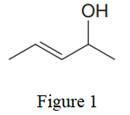
In the given line structure, there is a five carbon chain, with a carbon-carbon double bond and with a hydroxyl group. Each carbon atom is written explicitly followed immediately by the number of hydrogen atoms that are bonded to it. Multiple bonds are not shown explicitly in the condensed formula. Each carbon atom has a maximum of four bonds while each oxygen atom should have a maximum of two bonds. A parenthesis must be used for the carbon atom having three different groups attached. Thus, the hydroxyl group attached to the carbon atom must be shown in the parenthesis.
Thus, the condensed structure for the given line structure is:

The condensed structure for the given line structure is shown in Figure 2 above.
(b)
Interpretation:
Given line structure is to be drawn using condensed formula.
Concept introduction:
The condensed formula indicates how the atoms should be connected in a given molecule. Each carbon atom is written explicitly followed immediately by the number of hydrogen atoms that are bonded to it. To arrive at a total charge of zero, each carbon should have a maximum of four bonds while each oxygen should have a maximum of two bonds and two lone pairs. A parenthesis in the condensed formula represents that the repetitive unit is attached to the previous carbon atom. The
Answer to Problem 1.64P
For the given line structure, the condensed structure is:
![]()
Explanation of Solution
The given line structure is:
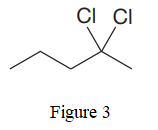
In the given line structure, there is a five carbon chain, with two chlorine atoms attached to one of the carbon atoms of the chain. Each carbon atom should have a maximum of four bonds while each oxygen atom should have a maximum of two bonds. A parenthesis must be used for the carbon atom having three different groups attached. Thus, the

The condensed structure for the given line structure is shown in Figure 4 above.
(c)
Interpretation:
Given line structure is to be drawn using condensed formula.
Concept introduction:
The condensed formula indicates how the atoms should be connected in a given molecule. Each non-hydrogen atom is written explicitly followed immediately by the number of hydrogen atoms that are bonded to it. Multiple bonds are not shown explicitly in the condensed structure. To arrive at a total charge of zero, each carbon should have a maximum of four bonds while each oxygen should have a maximum of two bonds and two lone pairs. A parenthesis in the condensed formula represents that the repetitive unit is attached to the previous carbon atom. The
Answer to Problem 1.64P
For the given line structure, the condensed structure is:
Explanation of Solution
The given line structure is:
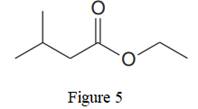
In the given line structure, there is a chain of four carbon atoms on the left side of a singly bonded oxygen. Each carbon atom is written explicitly followed immediately by the number of hydrogen atoms that are bonded to it. Multiple bonds are not shown explicitly in the condensed structure while an ethyl fragment is present at the right side of the singly bonded oxygen atom. The
Thus, the condensed structure for the given line structure is:

The condensed structure for the given line structure is shown in Figure 6 above.
(d)
Interpretation:
Given line structure is to be drawn using condensed formula.
Concept introduction:
The condensed formula indicates how the atoms should be connected in a given molecule. To arrive at a total charge of zero, each carbon should have a maximum of four bonds while each oxygen should have a maximum of two bonds and two lone pairs. A parenthesis in the condensed formula represents that the repetitive unit is attached to the previous carbon atom. Rings are generally now shown in their condensed formulas, but they are commonly shown in their partially condensed form. Multiple bonds in the ring and outside the ring are shows as they are. Parentheses are also used to clarify when two or three groups are attached to the same carbon atom.
Answer to Problem 1.64P
For the given line structure, the condensed structure is:
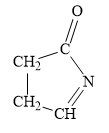
Explanation of Solution
The given line structure is:
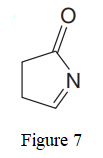
In the given line structure, a five membered ring containing a nitrogen atom is present. While writing a condensed formula, a ring is shown in its partial condensed formula. One of the carbon atoms in the ring forms a double bond with the oxygen atom which is shown as is.
Thus, the condensed structure for the given line structure is:
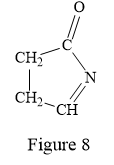
The condensed structure for the given line structure is shown in Figure 8 above.
(e)
Interpretation:
Given line structure is to be drawn using condensed formula.
Concept introduction:
The condensed formula indicates how the atoms should be connected in a given molecule. Each non-hydrogen atom is written explicitly, followed immediately by the number of hydrogen atoms that are bonded to it. Multiple bonds are not shown explicitly in the condensed structure. To arrive at a total charge of zero, each carbon should have a maximum of four bonds while each oxygen should have a maximum of two bonds and two lone pairs. A parenthesis in the condensed formula represents that the repetitive unit is attached to the previous carbon atom. Rings are generally shown in their condensed formulas, but they are commonly shown in their partially condensed form. Parentheses are also used to clarify when two or three groups are attached to the same carbon atom.
Answer to Problem 1.64P
For the given line structure, the condensed structure is:
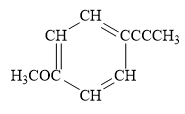
Explanation of Solution
The given line structure is:
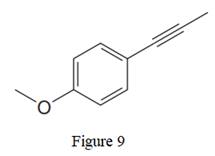
In the above line structure, the disubstituted benzene ring is present. One substituent of the benzene ring is a three carbon chain with an internal triple bond. The other substituent is a methoxy group,
Thus, the condensed structure for the given line structure is:
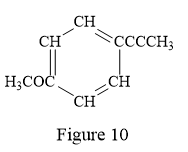
The condensed structure for the given line structure is shown in Figure 10 above.
(f)
Interpretation:
Given line structure is to be drawn using condensed formula.
Concept introduction:
The condensed formula indicates how the atoms should be connected in a given molecule. Each non-hydrogen atom is written explicitly, followed immediately by the number of hydrogen atoms that are bonded to it. To arrive at a total charge of zero, each carbon should have a maximum of four bonds while each oxygen should have a maximum of two bonds and two lone pairs. A parenthesis in the condensed formula represents that the repetitive unit is attached to the previous carbon atom. Rings are generally now shown in their condensed formulas, but they are commonly shown in their partially condensed form. Parentheses are also used to clarify when two or three groups are attached to the same carbon atom. A formal charge is shown explicitly on the atom.
Answer to Problem 1.64P
For the given line structure, the condensed structure is:
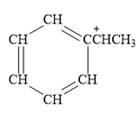
Explanation of Solution
The given line structure is:
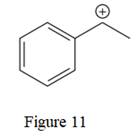
The above line structure is a structure for a cation. A carbocation is a carbon bearing a positive formal charge which is explicitly shown in the condensed formula. A six membered carbon ring with alternate double and single bonds is present and is shown as a partial condensed structure.
Thus, the condensed structure for the given line structure is:
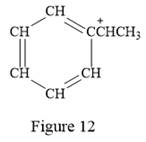
The condensed structure for the given line structure is shown in Figure 12 above.
(g)
Interpretation:
Given line structure is to be drawn using condensed formula.
Concept introduction:
The condensed formula indicates how the atoms should be connected in a given molecule. Each non-hydrogen atom is written explicitly, followed immediately by the number of hydrogen atoms that are bonded to it. To arrive at a total charge of zero, each carbon should have a maximum of four bonds while each oxygen should have a maximum of two bonds and two lone pairs. A parenthesis in the condensed formula represents that the repetitive unit is attached to the previous carbon atom. Rings are generally now shown in their condensed formulas, but they are commonly shown in their partially condensed form. Parentheses are also used to clarify when two or three groups are attached to the same carbon atom. A formal charge is shown explicitly on the atom.
Answer to Problem 1.64P
For the given line structure, the condensed structure is:
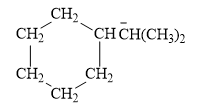
Explanation of Solution
The given line structure is:
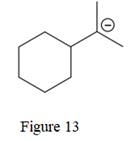
The above line structure is a structure for an anion. A six membered carbon ring with single bonds is present. Each carbon atom is written explicitly followed immediately by the number of hydrogen atoms that are bonded to it. The negative charge on the carbon atom is shown explicitly. The two methyl groups attached to the carbon bearing a negative charge are shown in the parenthesis.
Thus, the condensed structure for the given line structure is:
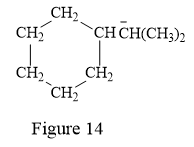
The condensed structure for the given line structure is shown in Figure 14 above.
(h)
Interpretation:
Given line structure is to be drawn using condensed formula.
Concept introduction:
The condensed formula indicates how the atoms should be connected in a given molecule. Each non-hydrogen atom is written explicitly, followed immediately by the number of hydrogen atoms that are bonded to it. To arrive at a total charge of zero, each carbon should have a maximum of four bonds while each oxygen should have a maximum of two bonds and two lone pairs. A parenthesis in the condensed formula represents that the repetitive unit is attached to the previous carbon atom. Rings are generally now shown in their condensed formulas, but they are commonly shown in their partially condensed form. Parentheses are also used to clarify when two or three groups are attached to the same carbon atom. A formal charge is shown explicitly on the atom.
Answer to Problem 1.64P
For the given line structure, the condensed structure is:
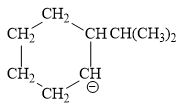
Explanation of Solution
The given line structure is:
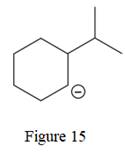
The above line structure is a six membered ring with a negative charge on one of the carbon atoms of the ring. The carbon bearing a negative charge is shown as is. The ring is monosubstituted with an isopropyl group. The two methyl groups in the isopropyl fragments is shown with the help of parenthesis.
Thus, the condensed structure for the given line structure is:
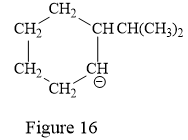
The condensed structure for the given line structure is shown in Figure 16 above.
(i)
Interpretation:
Given line structure is to be drawn using condensed formula.
Concept introduction:
The condensed formula indicates how the atoms should be connected in a given molecule. To arrive at a total charge of zero, each carbon should have a maximum of four bonds while each oxygen should have a maximum of two bonds and two lone pairs. A parenthesis in the condensed formula represents that the repetitive unit is attached to the previous carbon atom. The
Answer to Problem 1.64P
For the given line structure, the condensed structure is:
![]()
Explanation of Solution
The given line structure is:
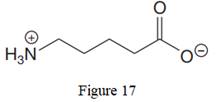
The above line structure is a chain of five carbon atoms. One end of the chain has carboxylate ion, in which the oxygen carries a negative charge. The other end of the chain has a nitrogen atom with three hydrogen atoms directly attached to it and carrying a positive charge. Formal charges on atoms are shown explicitly.
Thus, the condensed structure for the given line structure is:

The condensed structure for the given line structure is shown in Figure 18 above.
Want to see more full solutions like this?
Chapter 1 Solutions
ORGANIC CHEMISTRY PRINCIPLES & MECHANISM
- Draw product A, indicating what type of reaction occurs. NH2 F3C CF3 NH OMe NH2-NH2, ACOH Aarrow_forwardPhotochemical smog is formed in part by the action of light on nitrogen dioxide. The wavelength of radiation absorbed by NO2 in this reaction is 197 nm.(a) Draw the Lewis structure of NO2 and sketch its π molecular orbitals.(b) When 1.56 mJ of energy is absorbed by 3.0 L of air at 20 °C and 0.91 atm, all the NO2 molecules in this sample dissociate by the reaction shown. Assume that each absorbed photon leads to the dissociation (into NO and O) of one NO2 molecule. What is the proportion, in parts per million, of NO2 molecules in this sample? Assume that the sample behaves ideally.arrow_forwardCorrect each molecule in the drawing area below so that it has the skeletal ("line") structure it would have if it were dissolved in a 0.1 M aqueous solution of HCI. If there are no changes to be made, check the No changes box under the drawing area. No changes. HO Explanation Check NH, 2 W O :□ G ©2025 M unter Accessibilityarrow_forward
- An expression for the root mean square velocity, vrms, of a gas was derived. Using Maxwell’s velocity distribution, one can also calculate the mean velocity and the most probable velocity (mp) of a collection of molecules. The equations used for these two quantities are vmean=(8RT/πM)1/2 and vmp=(2RT/M)1/2 These values have a fixed relationship to each other.(a) Arrange these three quantities in order of increasing magnitude.(b) Show that the relative magnitudes are independent of the molar mass of the gas.(c) Use the smallest velocity as a reference for establishing the order of magnitude and determine the relationship between the larger and smaller values.arrow_forwardThe reaction of solid dimethylhydrazine, (CH3)2N2H2, and liquefied dinitrogen tetroxide, N2O4, has been investigated for use as rocket fuel. The reaction produces the gases carbon dioxide (CO2), nitrogen (N2), and water vapor (H2O), which are ejected in the exhaust gases. In a controlled experiment, solid dimethylhydrazine was reacted with excess dinitrogen tetroxide, and the gases were collected in a closed balloon until a pressure of 2.50 atm and a temperature of 400.0 K were reached.(a) What are the partial pressures of CO2, N2, and H2O?(b) When the CO2 is removed by chemical reaction, what are the partial pressures of the remaining gases?arrow_forwardOne liter of chlorine gas at 1 atm and 298 K reacts completely with 1.00 L of nitrogen gas and 2.00 L of oxygen gas at the same temperature and pressure. A single gaseous product is formed, which fills a 2.00 L flask at 1.00 atm and 298 K. Use this information to determine the following characteristics of the product:(a) its empirical formula;(b) its molecular formula;(c) the most favorable Lewis formula based on formal charge arguments (the central atom is N);(d) the shape of the molecule.arrow_forward
- How does the square root mean square velocity of gas molecules vary with temperature? Illustrate this relationship by plotting the square root mean square velocity of N2 molecules as a function of temperature from T=100 K to T=300 K.arrow_forwardDraw product B, indicating what type of reaction occurs. F3C CF3 NH2 Me O .N. + B OMearrow_forwardBenzimidazole E. State its formula. sState the differences in the formula with other benzimidazoles.arrow_forward
- Draw product A, indicating what type of reaction occurs. F3C CN CF3 K2CO3, DMSO, H₂O2 Aarrow_forward19) Which metal is most commonly used in galvanization to protect steel structures from oxidation? Lead a. b. Tin C. Nickel d. Zinc 20) The following molecule is an example of a: R₁ R2- -N-R3 a. Secondary amine b. Secondary amide c. Tertiary amine d. Tertiary amidearrow_forwardpls helparrow_forward
 ChemistryChemistryISBN:9781305957404Author:Steven S. Zumdahl, Susan A. Zumdahl, Donald J. DeCostePublisher:Cengage Learning
ChemistryChemistryISBN:9781305957404Author:Steven S. Zumdahl, Susan A. Zumdahl, Donald J. DeCostePublisher:Cengage Learning ChemistryChemistryISBN:9781259911156Author:Raymond Chang Dr., Jason Overby ProfessorPublisher:McGraw-Hill Education
ChemistryChemistryISBN:9781259911156Author:Raymond Chang Dr., Jason Overby ProfessorPublisher:McGraw-Hill Education Principles of Instrumental AnalysisChemistryISBN:9781305577213Author:Douglas A. Skoog, F. James Holler, Stanley R. CrouchPublisher:Cengage Learning
Principles of Instrumental AnalysisChemistryISBN:9781305577213Author:Douglas A. Skoog, F. James Holler, Stanley R. CrouchPublisher:Cengage Learning Organic ChemistryChemistryISBN:9780078021558Author:Janice Gorzynski Smith Dr.Publisher:McGraw-Hill Education
Organic ChemistryChemistryISBN:9780078021558Author:Janice Gorzynski Smith Dr.Publisher:McGraw-Hill Education Chemistry: Principles and ReactionsChemistryISBN:9781305079373Author:William L. Masterton, Cecile N. HurleyPublisher:Cengage Learning
Chemistry: Principles and ReactionsChemistryISBN:9781305079373Author:William L. Masterton, Cecile N. HurleyPublisher:Cengage Learning Elementary Principles of Chemical Processes, Bind...ChemistryISBN:9781118431221Author:Richard M. Felder, Ronald W. Rousseau, Lisa G. BullardPublisher:WILEY
Elementary Principles of Chemical Processes, Bind...ChemistryISBN:9781118431221Author:Richard M. Felder, Ronald W. Rousseau, Lisa G. BullardPublisher:WILEY





